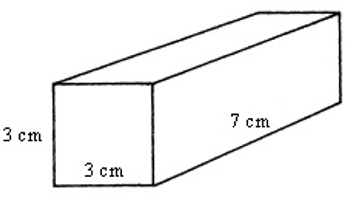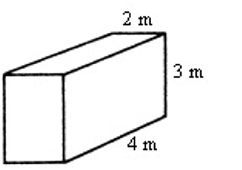| << Chapter < Page | Chapter >> Page > |
23.4
a) 108 cubic cm
b) 72 cubic cm
c) 23,625 cubic cm
d) 108 cubic cm
23.5
a) 20 cubic cm
b) 63 000 cubic mm
c) 24 000 cubic cm
d) 1 728 cubic cm
e) own answer
23. VOLUME
23.1 Did you know?
The amount of space that is taken up by a solid body is called the volume of the body.
The internal volume is thus the space inside a hollow container. It is also called the capacity or contents of the container.
23.2 IMPORTANT to REMEMBER!
Volume is measured in cubic measuring units
We use the following units:
cubic mm : mm³
cubic cm : cm³
cubic m : m³
1 cm³ (cubic centimetre) is a cube with a length, breadth and height of 1 cm.
1 cm³ = 1 cm x 1 cm x 1 cm
= 10 mm x 10 mm x 10 mm
= 1 000 mm3
1 m³ = 1 m x 1 m x 1 m
= 100 cm x 100 cm x 100 cm
= 1 000 000 cm³
23.3 Also LEARN the following:
Volume of a rectangular prism is length x breadth x height
Volume of a cube is y³ y = (length, breadth and height)
23.4 Use the formula: volume = length x breadth x height
to calculate the volume of the following figures:

___________________________________________________
___________________________________________________
___________________________________________________
b)

___________________________________________________
___________________________________________________
___________________________________________________
c)

___________________________________________________
___________________________________________________
___________________________________________________

___________________________________________________
___________________________________________________
___________________________________________________
___________________________________________________
___________________________________________________
___________________________________________________
23.5 a) Calculate the volume of the following in cm3:

___________________________________________________
___________________________________________________
___________________________________________________
___________________________________________________
___________________________________________________
___________________________________________________
b) Calculate the volume of the following in mm3

___________________________________________________
___________________________________________________
___________________________________________________
___________________________________________________
___________________________________________________
___________________________________________________
c) What is the volume of the figure in cm3?

___________________________________________________
___________________________________________________
___________________________________________________
___________________________________________________
___________________________________________________
___________________________________________________
d) Calculate the volume of a cube with a length of 12 cm.
___________________________________________________
___________________________________________________
___________________________________________________
___________________________________________________
e) Estimate the volume of the box of chalk in your classroom
___________________________________________________
___________________________________________________
___________________________________________________
___________________________________________________
23.6 CLASS DISCUSSION
How will you determine the volume of an irregular figure, e.g. a stone?
23.6.1 Did you know?
A Greek Mathematician, Archimedes, discovered how to calculate the volume of an irregular figure while he was bathing! He saw how water flowed over the edge of the bath when he climbed in. He realised that if he could measure the volume of water that his body displaced, then he could measure the volume of his own body. Archimedes was so excited by this realisation that he jumped out of the bath and ran down the street stark naked shouting, “EUREKA!” (I have found it!)
23.6.2 Follow the following steps and see if you can measure the volume of a stone that you have picked up outside.
a) Fill a cup completely to the top with water and put the cup in a bigger container. Remember to see precisely how many mℓ water you have in the cup!
b) Slowly lower the stone into the cup. Make certain that the water that overflows lands in the bigger container.
c) Measure the amount of water in the container by pouring it into a measuring cup.
d) Your stone has a volume of 1 cm3 for each mℓ of water that overflowed because 1 mℓ = 1 cm³.
e) What is the volume of your stone? .__________________________________
Learning Outcome 4: The learner will be able to use appropriate measuring units, instruments and formulae in a variety of contexts.
Assessment Standard 4.2: We know this when the learner solves problems;
Assessment Standard 4.3: We know this when the learner solves problems using a range of strategies.

Notification Switch
Would you like to follow the 'Mathematics grade 7' conversation and receive update notifications?